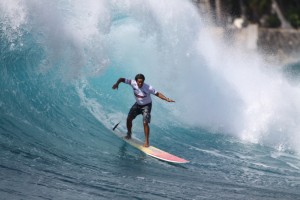 As most of you already know, I LOVE to surf. Surfing gives me an incredible rush of adrenaline and sense of freedom that I just don’t find in other sports. However, with reward (a really fun ride) comes very hard work (all the paddling). I’ve always known surfing to be a very physically demanding sport, one that requires strength, balance, endurance and flexibility.
As most of you already know, I LOVE to surf. Surfing gives me an incredible rush of adrenaline and sense of freedom that I just don’t find in other sports. However, with reward (a really fun ride) comes very hard work (all the paddling). I’ve always known surfing to be a very physically demanding sport, one that requires strength, balance, endurance and flexibility.
It’s always been hard to quantify just how strenuous a surfing session is, as it’s hard to determine and/or record calories burned, heart rate fluctuations and distance paddled during an average surf session. However, just recently a group of doctors in New Zealand aimed to find these answers to these questions.
The Surfing Study
Recently, a team of researchers from Auckland University of Technology, lead by Olly R.L. Farley, ran a study examining 12 nationally ranked surfers in New Zealand, analyzing the physical demands during 20 minute heats in sanctioned surfing contests.
The surfers were videotaped as they performed competitive heats, while wearing a global positioning system (GPS) unit and heart rate monitor. The data was broken down to measure the time spent in various types of surfing activities (paddling out, paddling for a wave, waiting for a wave and riding a wave), the physical demands of each activity, as well as the speed and distance traveled.
Results of the Study
Cardiovascular Breakdown
- 139 bpm was the average heart rate during competition
- 190 bpm was the peak heart rate
- 2/3 of the time was spent with heart rates in the moderate- to high-intensity range
- Highest heart rates occurred right after the surfers finished riding the waves
The researchers expected that heart rates would be their highest when the athletes were paddling to catch a wave — but instead found that the highest rates occurred right after the surfers finished riding a wave. One reason for such a result could be the physical demands of riding the wave, coupled with the adrenaline release generated from the wave ride and fall.
Activity Breakdown
- 60% of time spent on paddling
- 28% of time was spent stationary on boards, waiting for a wave
- 8% of time was spent actually ridding a wave
- 4% of time was spent paddling for the wave
- surfers paddled an average distance of about 1 mile during the 20 minute heat
However, surfers have to respond quickly to ever-changing conditions, always keeping an eye on approaching waves. The study found that the majority of surfing activities seldom lasted longer than 10 seconds…meaning, surfers engage in multiple activities (paddling out, catching a wave, riding a wave, waiting for a wave)
Speed Breakdown
- 2.3 MPH was the average paddling speed
- 20.75 mph was the average peak speed while riding a wave
- 27.96 mph was the fastest recorded speed while riding a wave
*These speeds were absolute, subject to wave height, conditions and type of break. Lovin those speed times…that’s what makes surfing so much fun 🙂
The Adrenaline Effect
This was not part of the study, but as cited above, surfers experience the highest heart rate when just completing a ride. This higher than normal heart rate is often referred to as an adrenaline rush. Adrenaline is a hormone that is secreted by the adrenal glands when the brain sends a signal that there is a need for the fight or flight response needed. Now, not all adrenaline is created equal.
Researches have found that adventure sports (such as surfing, skiing, rock climbing) which create the adrenaline rush affect have a positive effect on your stress levels…not by reducing stress, but rather by helping your body produce more positive stress, which then conditions your body and mind to better handle stress in everyday life.
Get Surf Fit
To keep you surfing well into older age, you need to start a surf specific training & conditioning routine. Surf-specific training will help you condition your body and heart for the interval-style exertion that surfing requires. Surf-specific training focuses on building the strength, endurance and balance needed to progress your surfing, either into bigger waves or into older age, or both! But, dont take my word for it…just look at current world surfing champ Kelly Slater’s training and nutrition program. He’s still dominating the tour and credits both his surf-specific training and stretching, as well as strict diet for keeping his body in peak performance shape.
